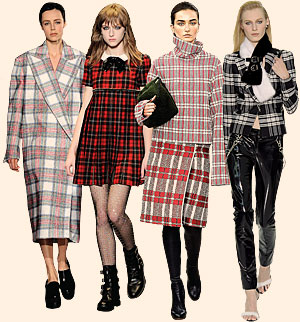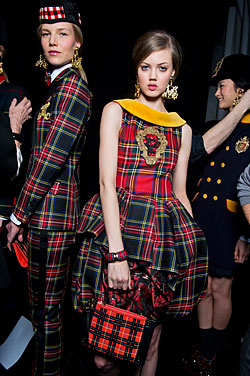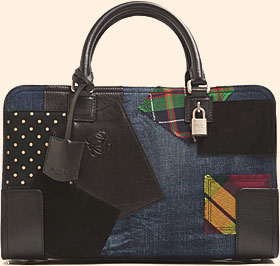Why tartan is back on the catwalk

Roula Khalaf, Editor of the FT, selects her favourite stories in this weekly newsletter.
Fashion doesn’t get much more Scottish than model Stella Tennant, prowling through the ruins of Linlithgow Palace in West Lothian, lit by flaming braziers, wearing head-to-toe tartan. Chanel’s presentation of its pre-fall collection – a celebration of the craft of its longstanding cashmere collaborators Barrie, which has its factory on the Scottish Borders – heralded a season devoted to all manner of clan-inspired checks.
For starters there is primary red, classic Stewart tartan with all the trimmings, reworked into women’s tuxedos, puffball dresses and riding coats at Moschino; twilight blue tartan suits at Alberta Ferretti, with high collars and pleated pelmet detail, and a collaboration between Loewe and Junya Watanabe Comme des Garçons that features the pattern in bold patches on numerous bags and denim (£1,850) .
“We definitely saw a comeback for tartan for autumn,” says Rebecca Osei-Baidoo, womenswear buyer at Browns in London. “Chanel, Céline and MSGM interpreted their version of it in shirts, skirts and coats, and gave it a twist to make it more modern and easy for customers to wear.”
At Clements Ribeiro it was pretty and symmetrical, worked into dresses with criss-cross lace details and cute kilts (£580). Stella McCartney used it on voluminous and masculine coats (£1,800) to dramatic effect. She manipulated textures as well as pattern: “We needle-punched the tartan so it’s softer and more luxurious,” she says. “It plays with colour and scale, combining a nod to tomboy sensitivity and British tradition.”
Some designers are synonymous with tartan; Jean Paul Gaultier has included it in his work for decades, and this season he showed a chic high-neck top in the pattern, styled with a matching skirt worn over trousers. His tartan – in red and green versions – is stark but electric, bright and contemporary. “I saw the punks wear it when I started going to London in the 1970s,” he says. “That’s where I understood that it could be subversive. I embraced it and keep coming back to it. It’s a traditional fabric, used throughout the centuries, which suddenly became a symbol of rebellion and anti-conformism.”

In fact, tartan’s roots are firmly planted in violent rebellion. The McQ collection this season features the usual nods to the late Lee Alexander McQueen’s heritage (tartan dress, £250; T-shirt, £155), which is something he embraced in the most aggressive way imaginable when he showed his Highland Rape collection in London in 1995.
“Lee was Scottish and that show was about commandeering a particular Scottish attitude,” says fashion historian Judith Watt, a friend of the late designer whose recent book Alexander McQueen: The Life and Legacy is a definitive and candid study of his work. “Tartan was crafted to give identity to the diaspora of the Scottish clans. Highland Rape was all about the Highland Clearances by the English in 1745. It was a story about the rape of land and heritage. The tartan that Lee used was a MacDonald tartan, developed from a plaid that had been outlawed and buried by one of his ancestors.” McQueen continued to work with that same cloth in unexpected and innovative ways throughout his career, cutting and shaping it as no one else had before.
In fact, 1970s punk wasn’t the first time since the Clearances that the confrontational aspects of tartan had been utilised to inject fashion with a certain frisson. “There was actually a great interest in it in France in 1815, after Waterloo,” says Watt. “It became a personal statement. The French had been terrified of the Highland regiments and they began wearing it themselves, as printed silks.”
Ironically, it is tartan’s traditional nature and misperceived tweeness – after years of being aligned with shortbread and souvenir shops on Edinburgh’s Royal Mile – that can lend such a dynamic contrast in fashion. During the punk era, it was a case of being so wrong it was right. At Versace this season, it appears in monochrome, combined with black PVC and cut into the kind of single-strap, sleeveless dresses (£1,140) that Stephen Sprouse once made for Debbie Harry, circa “Heart of Glass”.

One of tartan’s first subculture outings after punk was during grunge, the early 1990s period that influenced and dominated Hedi Slimane’s show for Saint Laurent this season. Everything at Saint Laurent looked a little bit Courtney Love, right down to a tartan baby doll dress with white collar and bow (£2,545) worn with leather ankle boots.
For most who wear it today, tartan has nothing to do with rock’n’roll or the violently oppressive English monarchs of the 18th century; it’s merely a tasteful, alluring, opulent visual. The agenda – as fascinating and poignant as it is – is buried beneath aesthetics because, above all, it is beautiful. As Gaultier, the one-time enfant terrible of the fashion scene, says: “I don’t see tartan as a symbol of rebellion at all. It’s more like meeting a dear friend that you know is always there for you.”
Comments